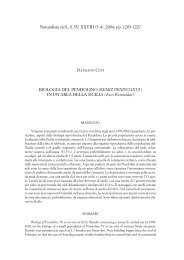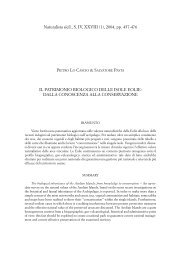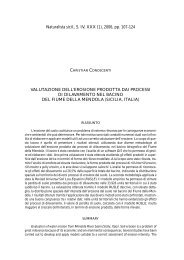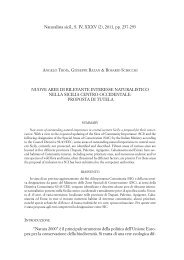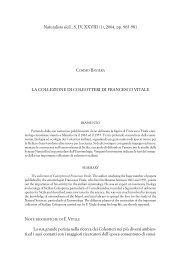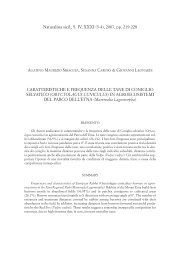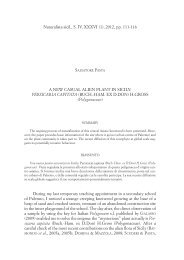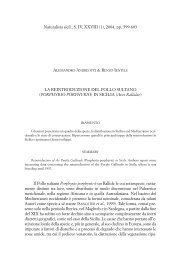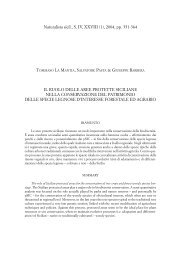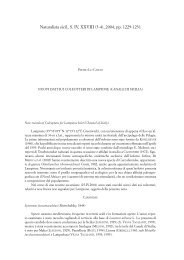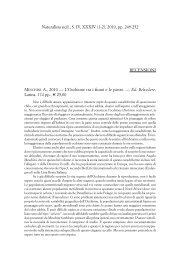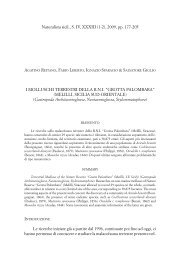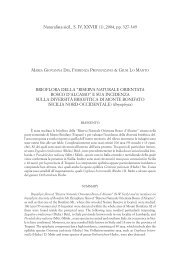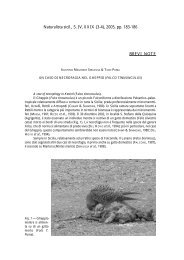2007,pp - Società Siciliana di Scienze Naturali
2007,pp - Società Siciliana di Scienze Naturali
2007,pp - Società Siciliana di Scienze Naturali
You also want an ePaper? Increase the reach of your titles
YUMPU automatically turns print PDFs into web optimized ePapers that Google loves.
286 M. SKUHRAVÁ, V. SKUHRAVY´ & B. MASSA<br />
Macro<strong>di</strong>plosis roboris (Hardy, 1854)<br />
Syn. Macro<strong>di</strong>plosis volvens Kieffer, 1895<br />
Larvae cause galls on Quercus robur L., Q. petraea (Matt.) Liebel and related<br />
species (Fagaceae). The gall is formed by a rolled leaf margin segment, situated<br />
between two lobes (Pl. I, Fig. 1). Only one generation develops per year.<br />
Fully grown larvae leave galls, fall to the ground and enter the soil where they<br />
remain till the spring of the following year. Occurrence: DE STEFANI (1907a)<br />
recorded galls found on Quercus coccinea Wang. in the Botanical Garden of<br />
Palermo, the host plant originating from North America. LONGO et al. (2001)<br />
report this species on Q. pubescens from the Etna region. Distribution: European<br />
up to Kazakhstan; it was also found in Turkey (SKUHRAVÁ et al., 2005).<br />
Mayetiola destructor Say, 1817<br />
Syn. Cecidomyia cerealis Rondani, 1843<br />
Cecidomyia frumentaria Rondani, 1864<br />
White larvae cause swellings on the lower part of the stem on Triticum<br />
aestivum L. (T. vulgare Vill.), Secale cereale L. and occasionally also on various<br />
species of weed grasses (Poaceae). There are usually two generations per year.<br />
In Central Europe adults of the first generation emerge in May. Larvae feed<br />
by sucking the sap from the tissues of the stem just above a node; attacked<br />
parts of stems are swollen. Larvae pupate within a puparium on the stem.<br />
Adults emerge in late summer and produce the second generation. Larvae<br />
overwinter in puparia and pupate there in the following spring. When the<br />
infestation is severe, the young plants may <strong>di</strong>e. DARVAS et al. (2000) evaluate<br />
M. destructor as a minor pest of cereals in Europe, but the main pest of cereals<br />
in North America. Occurrence: MINÀ PALUMBO (1882) reported this<br />
species from Sicily. Distribution: Euro-Siberian species introduced from<br />
Europe to New Zealand and North America. At the present time, it seems to<br />
have nearly a cosmopolitan <strong>di</strong>stribution (SKUHRAVÁ et al., 1984a, 1984b).<br />
Mikiola fagi (Hartig, 1839)<br />
A solitary white larva produces a large, smooth (hairless) hard gall, pointed<br />
at the tip, on the u<strong>pp</strong>er leaf surface of Fagus sylvatica L. (Fagaceae). In summer<br />
the galls are green, later they become red (Pl. I, Figs. 2 and 3). In autumn<br />
galls fall to the soil and larvae overwinter inside them. In the following spring larvae<br />
pupate in galls and then adults emerge from them. Occurrence: DE STEFANI<br />
(1906c) recorded galls without giving locality. DE STEFANI jr (1942) reported<br />
galls from the Nebro<strong>di</strong> mountains, near Troina in June-September. LONGO et al.<br />
(2001) report the occurrence of this species from the Etna region. In recent times<br />
the galls were commonly found on Madonie, Nebro<strong>di</strong> and Etna, between 1400



